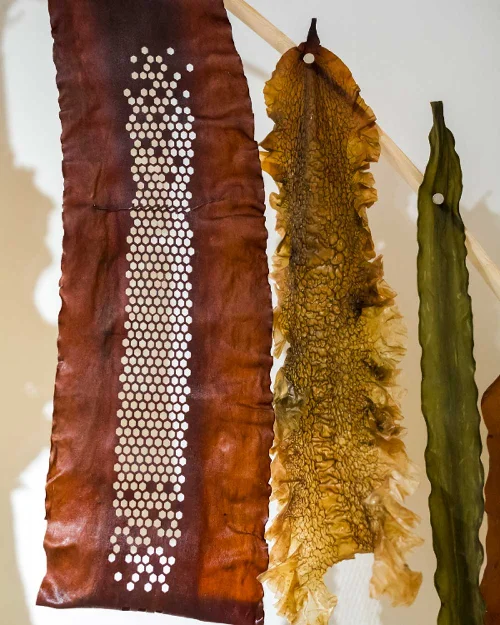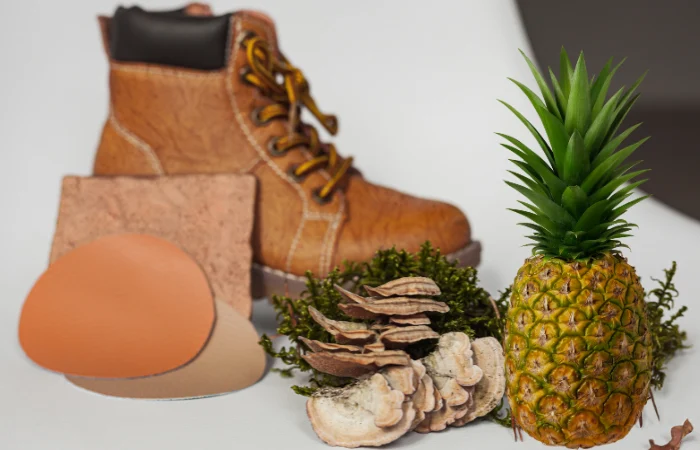As global consciousness shifts towards more sustainable and ethical choices, the rise of alternative vegan leathers isn’t just an economic or environmental phenomenon; it’s a reflection of a broader cultural transformation. The way societies value and perceive materials is changing. Leather, once a symbol of luxury and durability, is now under scrutiny for its ethical implications and environmental toll.
Meanwhile, materials like Piñatex and Mycelium, which may have once been dismissed as niche or even eccentric, are gaining mainstream appeal not just for their eco-credentials, but for their innovative nature and the story they tell about a product’s origin.
This story – of connecting with nature, of utilizing waste, and of pioneering new sustainable technologies – is becoming as valuable to consumers as the product itself. Brands aren’t just selling items; they’re selling narratives of change, hope, and a greener future.
In many ways, the rise of these materials signifies a departure from purely transactional consumerism to one that’s more experiential and value driven.
Moreover, as these materials become more widespread, it wouldn’t be surprising to see them transcend beyond fashion and accessories. We might soon witness a world where Mycelium isn’t just for bags and shoes but also for upholstery, car interiors, and other traditionally leather-dominated spaces.
We still must approach this realm with cautious optimism. The allure of “green” and “sustainable” can sometimes overshadow the need for rigorous scientific assessment and transparent supply chains. As with any burgeoning industry, oversight and standards will be crucial to ensure that these vegan leather alternatives truly live up to their potential and promise.
Suffice it to say, there’s a lot at stake here, considering the overall size of the traditional leather options…
The Traditional Leather Industry Is Huge
The global leather goods market (footwear, clothing, and other products) was valued at around USD $456.4 billion in 2022 and is expected to grow at a compound annual growth rate (CAGR) of roughly 5% from now to 2027, which means projections for 2027 and beyond could see it approaching or surpassing $580 billion, considering various factors including demand and market fluctuations.
The Vegan Leather (Including PU and PVC) Industry Is Growing Faster
The global vegan leather market was valued at approximately USD $31.7 billion in 2022 and is predicted to grow at a CAGR of about 9.1% from now to 2027. This means that by 2027, its value could be approaching or exceeding $48 billion. Of course, most of this market consists of oil-based polyurethane (PU) and polyvinyl chloride (PVC) leathers.
The increased growth rate for vegan leather compared to traditional leather isn’t surprising, considering the ever-increasing consumer demand for more ethically produced and environmentally friendly alternatives. Still, the traditional leather market remains much larger in total value.
Now that we know the background, let’s dig into the newer faux leather options that just might prove more eco-friendly overall and economically viable.
The leading two options, pineapple, and mushroom, are close to market with a few expensive options available now (primarily to help fund additional research and mass production efforts). The most promising up-and-coming leather alternatives are years away but carry even more benefits.
Piñatex (Pineapple Leather)
Derived from the fibers of pineapple leaves, a byproduct of the pineapple farming industry, Piñatex is produced by felting these fibers into a non-woven material. This material is then given a protective coating to make it more durable.
Advantages
- Sustainability: Utilizes waste from the pineapple industry.
- Biodegradability: Has a higher biodegradability compared to plastic-based vegan leathers.
- Economic Impact: Provides an additional revenue stream to pineapple farmers.
Disadvantages
- While more sustainable than PVC or PU, it still requires a protective coating, which can diminish its environmental credentials.
Compared to Traditional Vegan Leather
- More environmentally friendly and biodegradable.
- Texturally more organic and less plastic-like.
Compared to Real Leather
- Lighter in weight.
- Does not have the longevity of genuine leather, but is a close competitor in terms of feel and aesthetics.
Mycelium Leather (Mushroom Leather)
Mycelium, the root system of fungi, is grown in agricultural waste to form interwoven threads. When harvested, it’s processed and compressed to resemble leather. In fact, recently a team of researchers discovered self-healing fungi-based leather, meaning clothes will last ten times longer than before (the fast fashion industry should be concerned about that).
Advantages
- Sustainability: Grown on agricultural waste, minimizing resource input.
- Customizability: Growing conditions can be tweaked to produce desired textures and thickness.
- Biodegradability: Being an organic material, mycelium leather is biodegradable.
Disadvantages
- Production scale and speed is still being optimized.
Compared to Traditional Vegan Leather
- Significantly more eco-friendly due to its organic nature and reduced chemical processing.
- Offers a unique texture distinct from PU or PVC.
Compared to Real Leather
- Offers similar tactile qualities.
- Has the potential for increased durability, but further research is required.
Possible Noteworthy Alternatives of The Near Future: Kelp and Fermented Protein
The following are promising up-and-coming alternatives. Both are still in their infancy with a lot more research ahead of them but both do have the potential to revolutionize vegan leather.
Kelp Leather
Kelp leather, as the name suggests, is derived from seaweed, particularly large brown algae commonly known as kelp.
These seaweeds grow in underwater “forests” in shallow oceans and are among the fastest-growing plants on Earth, with some types growing up to half a meter a day.
Sustainability and Harvesting
Kelp doesn’t require arable land, fresh water, pesticides, or fertilizers to grow, making it highly sustainable. When harvested sustainably, it doesn’t deplete the ocean’s resources or harm its ecosystem.
Instead, kelp farming can be beneficial for marine environments, providing habitats for various marine species and helping reduce ocean acidification by absorbing significant amounts of carbon dioxide.
Processing into Leather
Once harvested, the kelp undergoes processing to extract cellulose, which is then transformed into a durable material resembling leather.
The final product retains some of the unique textures of seaweed, offering a distinctive look and feel.

Advantages and Disadvantages
Beyond sustainability, kelp leather is lightweight, biodegradable, and can be produced with a lower carbon footprint than traditional leather or petroleum-based alternatives.
However, scalability, texture consistency, and durability in diverse conditions remain areas of ongoing research and development.
Fermented Protein Leather
Fermented protein leather represents a fusion of biotechnology and fashion. It’s an exciting frontier where microorganisms are harnessed to produce materials that can rival or even surpass the properties of traditional leather.
Production Process
At its core, the production of fermented protein leather involves feeding sugar to specific microorganisms, like yeast, which have been genetically modified. These microorganisms produce proteins during fermentation.
Once enough protein is produced, it’s processed, purified, and then assembled into a material structure that mimics the collagen matrix of animal leather.
Potential and Challenges
Because this is a biofabricated material, there’s a high degree of control over its properties. This means that in the future, we could have custom leathers with specific textures, thicknesses, or other desired attributes tailored to specific applications.
Moreover, the production process can be relatively clean, with reduced water usage and no need for harmful tanning chemicals.
However, the technology is still very young, with a great deal to be done yet.
Scaling production to meet global demand, driving down costs, ensuring consistent quality, and achieving a product that genuinely replicates the best attributes of animal leather are challenges that researchers and companies in the field are actively addressing.
Economic and Environmental Impacts
From an economic perspective, fermented protein leather could lead to new biotech-driven industries, reshaping economies, and job markets.
Environmentally, the potential to produce leather without livestock significantly reduces land, water, and resource consumption, and the associated methane emissions.
Economic Impacts
The rise of these new vegan leathers is reshaping economies:
- Boost to Agriculture: Many of these materials leverage agricultural waste or byproducts, providing farmers with an additional income source.
- Research & Development: The innovation-driven nature of these materials means more investments in R&D, leading to high-skilled job creation.
- Shift in Manufacturing Hubs: As production isn't tied to traditional leather-producing regions, there's potential for a geographical shift in manufacturing hubs, benefiting economies previously not involved in the leather industry.
Environmental Impact
Traditional leather has its environmental baggage — from the methane emissions of livestock to the chemicals used in tanning. PVC and PU vegan leathers, while eliminating the animal component, come with their own set of environmental issues, primarily due to their petrochemical origins and lack of biodegradability and most experts agree that traditional vegan leather is far from eco-friendly.
New vegan leathers like Piñatex and Mycelium come out significantly ahead in this triad:
- Reduced Carbon Footprint: Most of these materials have a lower carbon footprint in their production processes compared to both real leather and traditional vegan leather.
- Waste Reduction: Leveraging agricultural byproducts ensures waste is minimized.
- Less Water Intensive: Compared to real leather, which is incredibly water-intensive due to livestock needs, these alternatives require significantly less water. Of course, no one gets fed in the process, either.
But before you get too excited, keep in mind that many of these alternative leathers are in the beginning stages, and continued research is vital to understand their long-term impacts fully.
More To Discover
- 10 High-Tech Climate Solutions Worth Watching in 2024
- DOE Analysis Reveals Geothermal Heat Pumps Are A Key to a Sustainable Future
- 1.5 Billion Tires Are Thrown Away Annually, A New Recycling Method Can Transform Them Into High-Value Products
- Water Batteries: The Safe, Affordable, and Eco-Friendly Energy of the Future That Won’t Explode
Closing Thoughts...
The world of vegan leather is more diverse and exciting than ever before.
With materials derived from pineapples to fungi, the possibilities seem endless.
These innovations not only offer cruelty-free and more sustainable alternatives to traditional leather, but also have the potential to reshape economies, bolstering agricultural sectors and leading the charge in green innovation.
While challenges remain, one thing is clear: the future of leather alternatives is bright, varied, and holds the promise of a more sustainable world.



















